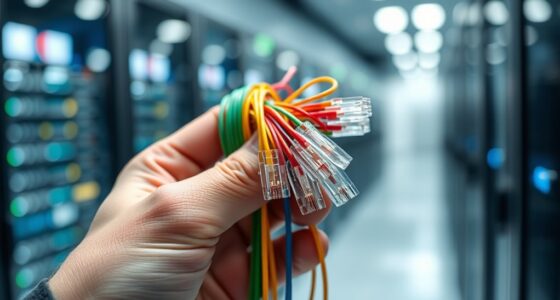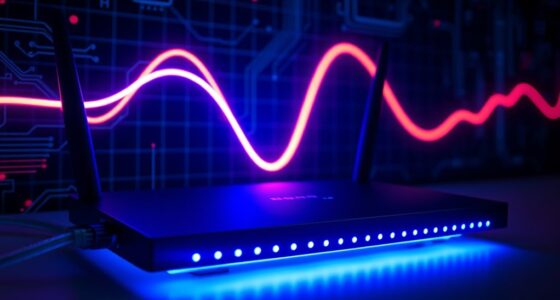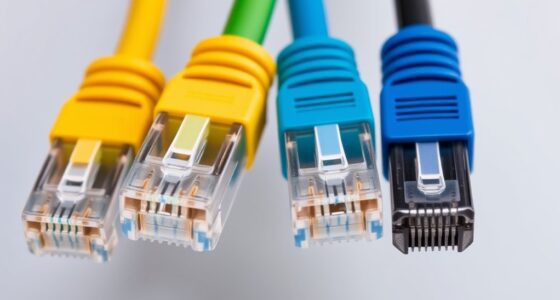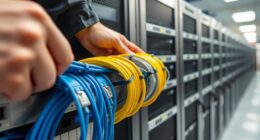When it comes to networking cables, impedance might seem like a technical detail, but it has a real impact on your network’s performance. Proper impedance guarantees signals travel smoothly without reflections or interference, which can cause data errors or slowdowns. If impedance isn’t matched correctly, your connection could become unreliable or degrade over time. Understanding why impedance matters can help you make smarter choices for a more stable and efficient network.
Key Takeaways
- Proper impedance matching minimizes signal reflections and loss, ensuring efficient data transmission.
- Correct impedance enhances shielding effectiveness, reducing external electromagnetic interference.
- Maintaining consistent impedance preserves signal integrity during cable flexing and installation.
- Impedance mismatch can cause signal degradation, resulting in network performance issues.
- Selecting cables with appropriate impedance improves overall network reliability and data quality.
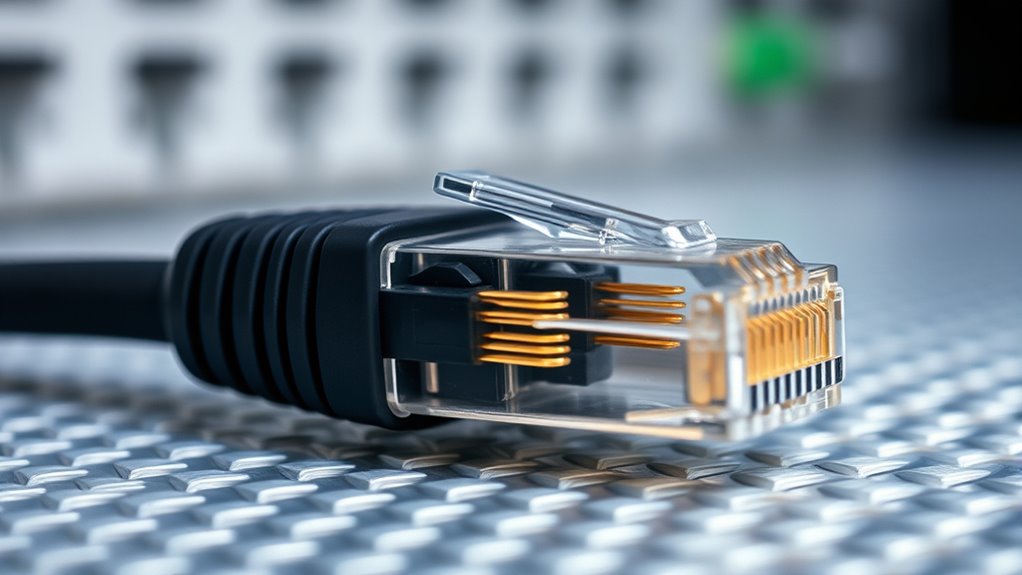
Impedance plays a essential role in the performance of networking cables, ensuring that signals transmit efficiently without interference or loss. When you’re setting up or maintaining a network, understanding impedance helps you choose the right cables to deliver consistent, high-quality data transfer. One key aspect affected by impedance is shielding effectiveness. Shielding protects signals from external electromagnetic interference (EMI), which can cause data corruption or slowdowns. Cables with proper impedance matching feature shielding that’s designed to work harmoniously with the cable’s internal structure, minimizing noise and maintaining signal integrity. If the shielding isn’t compatible or effective, external interference can seep into your signals, leading to errors and degraded network performance. That’s why selecting cables with ideal shielding effectiveness and correct impedance is essential, especially in environments packed with electronic devices or heavy machinery.
Another critical factor influenced by impedance is cable flexibility. Flexible cables are easier to install in tight spaces or around corners, but their flexibility shouldn’t compromise impedance consistency. When cables are overly flexible without proper design, their internal conductors may shift, causing impedance mismatches. These mismatches can result in signal reflections, loss, or attenuation, which weaken the overall network quality. Manufacturers design flexible cables with carefully balanced insulation and shielding layers to preserve impedance stability even when bent or twisted. This ensures that, despite their flexibility, the electrical properties stay consistent, and your signals remain clear and reliable. If you ignore the importance of cable flexibility in relation to impedance, you risk damaging the cable’s internal structure or creating points where interference can penetrate more easily. Additionally, advancements in AI-driven diagnostics are helping technicians detect impedance issues more efficiently during installation and maintenance.
In essence, matching impedance isn’t just about adhering to technical specifications — it directly impacts the shielding effectiveness and flexibility of your networking cables. Properly designed cables ensure that external interference is kept at bay while maintaining the physical flexibility you need for complex installations. When shopping for cables, pay attention to their impedance ratings and how they’re engineered for shielding and flexibility. Doing so guarantees that your network operates smoothly, with minimal disruptions and maximum data integrity. By understanding and prioritizing impedance, you’re investing in a more robust, reliable network infrastructure that can handle the demands of modern digital communication without compromise.
Frequently Asked Questions
How Does Impedance Affect Cable Length Limitations?
Impedance affects your cable length limitations because poor impedance matching causes signal reflections, leading to increased cable attenuation. When impedance isn’t matched, your signals weaken over longer distances, reducing performance. To maintain ideal data transfer, keep impedance consistent throughout the cable run, preventing reflections and attenuation buildup. This way, you can extend your cable length without sacrificing signal quality, ensuring reliable network connections.
Can Impedance Mismatches Cause Network Downtime?
A single impedance mismatch can cause network downtime so severe, it’s like your entire system crashes into a brick wall. When impedance isn’t matched properly, it leads to signal degradation and poor connector compatibility, which disrupts data flow. These issues can cause intermittent failures or complete network outages. To keep your network running smoothly, make sure your cables and connectors are perfectly impedance-matched, preventing costly downtime and maintaining reliable connectivity.
What Tools Are Used to Measure Cable Impedance?
You use impedance testing tools like a cable analyzer to measure cable impedance accurately. A cable analyzer sends test signals through the cable and analyzes the response, helping you identify impedance mismatches. These tools are essential for ensuring your network cables meet specifications, preventing signal reflections and data loss. Regular impedance testing with a reliable cable analyzer keeps your network running smoothly and maintains peak performance, avoiding costly downtime.
Are Certain Cable Types More Sensitive to Impedance Issues?
You bet certain cable types are more sensitive to impedance issues. For example, cables with specific materials like copper or twisted pairs are more prone to signal loss if impedance isn’t consistent. Connector design also plays a role, as poor connections can cause mismatched impedance. When these elements don’t align perfectly, you’re fighting an uphill battle with signal integrity. It’s like putting the cart before the horse—best to get it right from the start.
How Does Impedance Influence Signal Quality at High Frequencies?
Impedance directly affects signal quality at high frequencies by causing signal reflection if mismatched, leading to interference and data loss. It also influences high frequency attenuation, where signals weaken over distance. When impedance is properly matched, you reduce reflection and attenuation, ensuring clearer, faster data transmission. Conversely, mismatched impedance increases signal reflection and attenuation, degrading the overall network performance at high frequencies.
Conclusion
Think of impedance in networking cables like a perfectly tuned musical instrument—when everything aligns, the sound is clear and harmonious. By ensuring proper impedance matching, you prevent signal reflections and interference, keeping your network running smoothly. This stability is like a steady heartbeat, essential for reliable data flow. So, choosing cables with the right impedance isn’t just a detail; it’s the key to a high-quality, durable connection that performs flawlessly every time.



